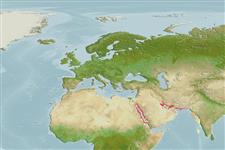Klassifizierung / Names
Namen | Synonyme | Catalog of Fishes(Gattung, Arten) | ITIS | CoL | WoRMS | Cloffa
>
Gobiiformes (Gobies) >
Xenisthmidae (Collared wrigglers)
Etymology: Xenisthmus: Greek, xenos = strange + Greek, isthmos = throat, narrow passage (Ref. 45335); oligoporus: Name from Greek 'oligos' for few and 'poros' for hole; referring to the relatively low number of sensory pores on the head; noun in apposition..
Environment: milieu / climate zone / depth range / distribution range
Ökologie
seewasser riff-verbunden; tiefenbereich 6 - 13 m (Ref. 115539). Tropical
Western Indian Ocean: Red Sea, Saudi Arabia.
Size / Gewicht / Alter
Maturity: Lm ? range ? - ? cm
Max length : 2.3 cm SL Männchen/unbestimmt; (Ref. 115539); 2.5 cm SL (female)
Kurzbeschreibung
Morphologie | Morphometrie
Rückenflossenstacheln (insgesamt): 7; Rückenflossenweichstrahlen (insgesamt): 14-15; Afterflossenstacheln 1; Afterflossenweichstrahlen: 13 - 14; Wirbelzahl: 26. This species is distinguished from it congeners in having a reduced number of cephalic
sensory pores (without A, I, J, K, P and Q pores) and in having 14-15 segmented rays in the second dorsal fin (Ref. 115539).
Found in sandy areas (Ref. 115539).
Life cycle and mating behavior
Geschlechtsreife | Fortpflanzung | Ablaichen | Eier | Fecundity | Larven
Gill, A.C., S.V. Bogorodsky and A.O. Mal, 2017. Review of Red Sea Xenisthmus Snyder, (Teleostei: Gobioidei: Xenisthmidae), with description of a new species. Zootaxa 4286(2):203-214. (Ref. 115539)
IUCN Rote Liste Status (Ref. 130435)
Bedrohung für Menschen
Harmless
Nutzung durch Menschen
Mehr Information
NamenSynonymeMetabolismusRäuberÖkotoxikologieFortpflanzungGeschlechtsreifeAblaichenSpawning aggregationFecundityEierEientwicklung
Alter/GrößeWachstumLänge-GewichtLänge-LängeLängenhäufigkeitenMorphometrieMorphologieLarvenLarven Pop.Dyn.RekrutierungDichteBRUVS
ReferenzenAquakulturAquakultur ProfilZuchtlinienGenetikElectrophoresesVererbbarkeitKrankheitenVerarbeitungNutrientsMass conversion
PartnerBilderStamps, Coins Misc.LauteCiguateraGeschwindigkeitSchwimmstilKiemenoberflächeOtolithsGehirngrößeSehfähigkeit
Tools
Zusatzinformationen
Download XML
Internet Quellen
Estimates based on models
Phylogenetic diversity index (Ref.
82804): PD
50 = 0.5020 [Uniqueness, from 0.5 = low to 2.0 = high].
Bayesian length-weight: a=0.00389 (0.00180 - 0.00842), b=3.12 (2.94 - 3.30), in cm total length, based on all LWR estimates for this body shape (Ref.
93245).
Trophic level (Ref.
69278): 3.1 ±0.4 se; based on size and trophs of closest relatives
Fishing Vulnerability (Ref.
59153): Low vulnerability (10 of 100).
